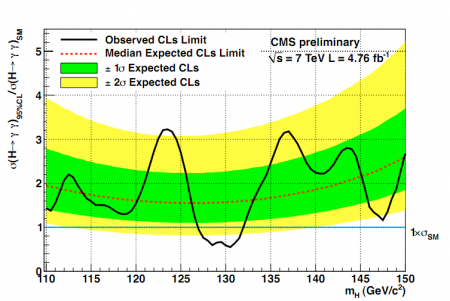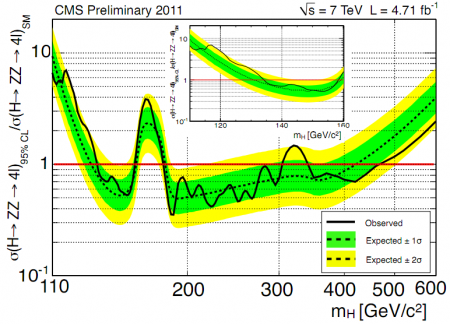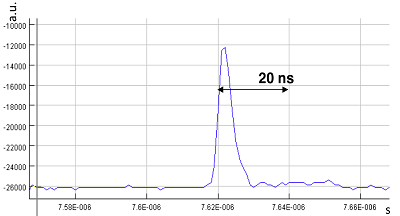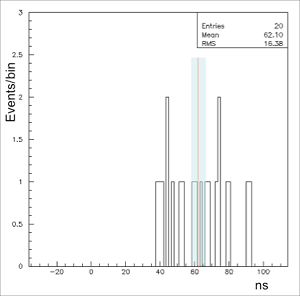NASA’s week of mourning begins tomorrow. The three deadly accidents in NASA’s history all happened in late January/early February. Apollo 1 caught fire 45 years ago on January 27, 1967, killing Grissom, White and Chaffee. Challenger exploded 26 years ago, on January 28, 1986, killing all seven on board. And Columbia broke up during reentry on February 1, 2003, just nine years ago, killing another seven people. Why these accidents all happened during the same calendar week remains a mystery.
When I write about things like precision orbit determination, I often have to discuss the difference between ephemeris time (ET) and coordinated universal time (UTC). ET is a “clean” time scale: it is essentially the time coordinate of an inertial coordinate frame that is attached to the barycenter of the solar system. On the other hand, UTC is “messy”: it is the time kept by noninertial clocks sitting here on the surface of the Earth. But the fact that terrestrial clocks sit inside the Earth’s gravity well and are subject to acceleration is only part of the picture. There are also those blasted leap seconds. It is because of leap seconds that terrestrial atomic time (TAI) and UTC differ.
Leap seconds arise because we insist on using an inherently wobbly planet as our time standard. The Earth wobbles, sometimes unpredictably (for instance, after a major earthquake) and we mess with our clocks. Quite pointlessly, as a matter of fact. And now, we missed another chance to get rid of this abomination: the International Telecommunication Union failed to achieve consensus, and any decision is postponed until 2015.
For the curious, an approximate formula to convert between TAI and ET is given by ET – TAI = 32.184 + 1.657×10–3 sin E, where E = M + 0.01671 sin M, M = 6.239996 + 1.99096871×10–7 t and t is the time in seconds since J2000 (that is, noon, January 1, 2000, TAI). To convert TAI to UTC, additional leap seconds must be added: 10 seconds for all dates prior to 1972, and then additional leap seconds depending on the date. Most inelegant.
Speaking of leap this and that, I think it’s also high time to get rid of daylight savings time. Its benefits are dubious at best, and I find the practice unnecessarily disruptive.
A couple of weeks ago, somewhere I saw a blog comment that mentioned a book, Rad Decision, written by nuclear engineer James Aach.
Back in the late 1970s, when I got my hands on The Prometheus Crisis by Scortia and Robinson, I just couldn’t put the damn thing down; I read through the night and I finished the book by the morning. So naturally, I couldn’t resist the temptation to buy the last in-stock copy of Aach’s book on Amazon.ca.
And I am glad I did. My concerns that it would be a trashy, amateurishly written novel quickly dissipated. Indeed, in a sense it is a lot better than The Prometheus Crisis: the crisis in Aach’s book is far less dramatic, but the story is believable, the characters perhaps more credible.
My only concern: while this book teaches a lot about nuclear power (and why we should not fear it), its likely audience already knows. Those who would benefit the most from reading it, well, won’t.
 Microsoft’s Windows 7 weather widget tells me that the temperature is -30 degrees Centigrade this morning in Ottawa. I know that this particular reading is an outlier (I don’t know where MSN get their reading from, but often it’s several degrees below that of others) but it’s still darn cold outside… even on our balcony it was -23 this morning. Welcome to Canada in January, I guess…
Microsoft’s Windows 7 weather widget tells me that the temperature is -30 degrees Centigrade this morning in Ottawa. I know that this particular reading is an outlier (I don’t know where MSN get their reading from, but often it’s several degrees below that of others) but it’s still darn cold outside… even on our balcony it was -23 this morning. Welcome to Canada in January, I guess…
Neutrinos recently observed by CERN’s OPERA experiment may have been traveling faster than light. Or may have not. I have been discussing with physicists a number of possibilities: the role of statistics, errors in time or distance measurements, comparisons to SN 1987A, Cherenkov radiation, or the necessity for a Lorentz-violating theoretical framework.
Fortunately, there is one thing I did not need to discuss: How faster-than-light neutrinos relate to the Koran. Physics educators in Pakistan, such as Pervez Hoodbhoy writing for the Express Tribune, are not this lucky: they regularly face criticisms from fundamentalists, and if they choose to confront these head-on, they provoke ominous reader comments that call on all Muslims to “reject this evil experiment”.
Yet, there is a glimpse of hope: a Pakistani reader mentions Carl Sagan’s The Demon-Haunted World, one of Sagan’s last books, and a superb one about rational thinking versus superstition. I don’t know how popular Sagan’s book is in Pakistan, but I am glad it’s not forgotten.
Has NASA nothing better to do than harass aging astronauts such as Jim Lovell who, some forty years after having survived a near-fatal accident in deep space (caused by NASA’s negligent storage and handling of an oxygen tank), is auctioning off a checklist containing his handwritten notes? A checklist that, had it remained in NASA’s possession, would likely have ended up in a dumpster decades ago?
This is so not kosher. Let Lovell sell his memorabilia in peace. If anyone has a right to do it, the survivors of Apollo 13 certainly do.
Here is a fascinating view of the India-Pakistan border, from the International Space Station:
Notice that strange orange line intersecting the landscape. Yes, that’s the border alright. It’s lit by floodlights along its entire length.
In 1968, the crew of Apollo 8, for the first time in the history of humanity, disappeared behind another celestial body. When they re-emerged on the other side and saw the Earth rise over the lunar landscape, on much of the Earth it was Christmas Day.
And this is when they sent us Earthlings a Christmas message, which ended with the words, “And from the crew of Apollo 8, we close with good night, good luck, a merry Christmas, and God bless all of you, all of you on the good Earth.”
You don’t need to be religious to find this moment awe-inspiring.
So I am reading details about the on-going search for the Higgs boson at the LHC. The media hailed the announcements this week as evidence that the hunt is nearing its goal… however, this is by no means conclusive, and instinctively, I’d be inclined to come to the opposite conclusion.
The Higgs boson, if exists as predicted, can decay into many things. It can decay into two photons. Just such a decay, consistent with a Higgs particle that is about 130 times heavier than a proton, was in fact observed by two of the LHC’s detectors, CMS:
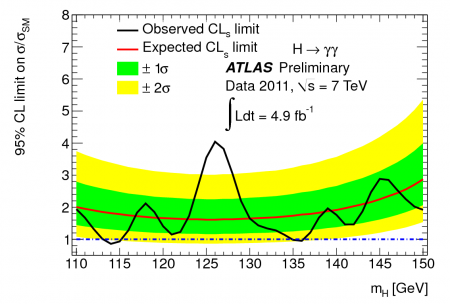 So far so good, but these signals are weak, far from conclusive. Never mind, both CMS and Atlas observed another slight peak. A Higgs particle can, in principle, also decay into two Z-bosons. Indeed, such a decay may be indicated by CMS (that ever so small bump near the extreme left of the plot):
So far so good, but these signals are weak, far from conclusive. Never mind, both CMS and Atlas observed another slight peak. A Higgs particle can, in principle, also decay into two Z-bosons. Indeed, such a decay may be indicated by CMS (that ever so small bump near the extreme left of the plot):
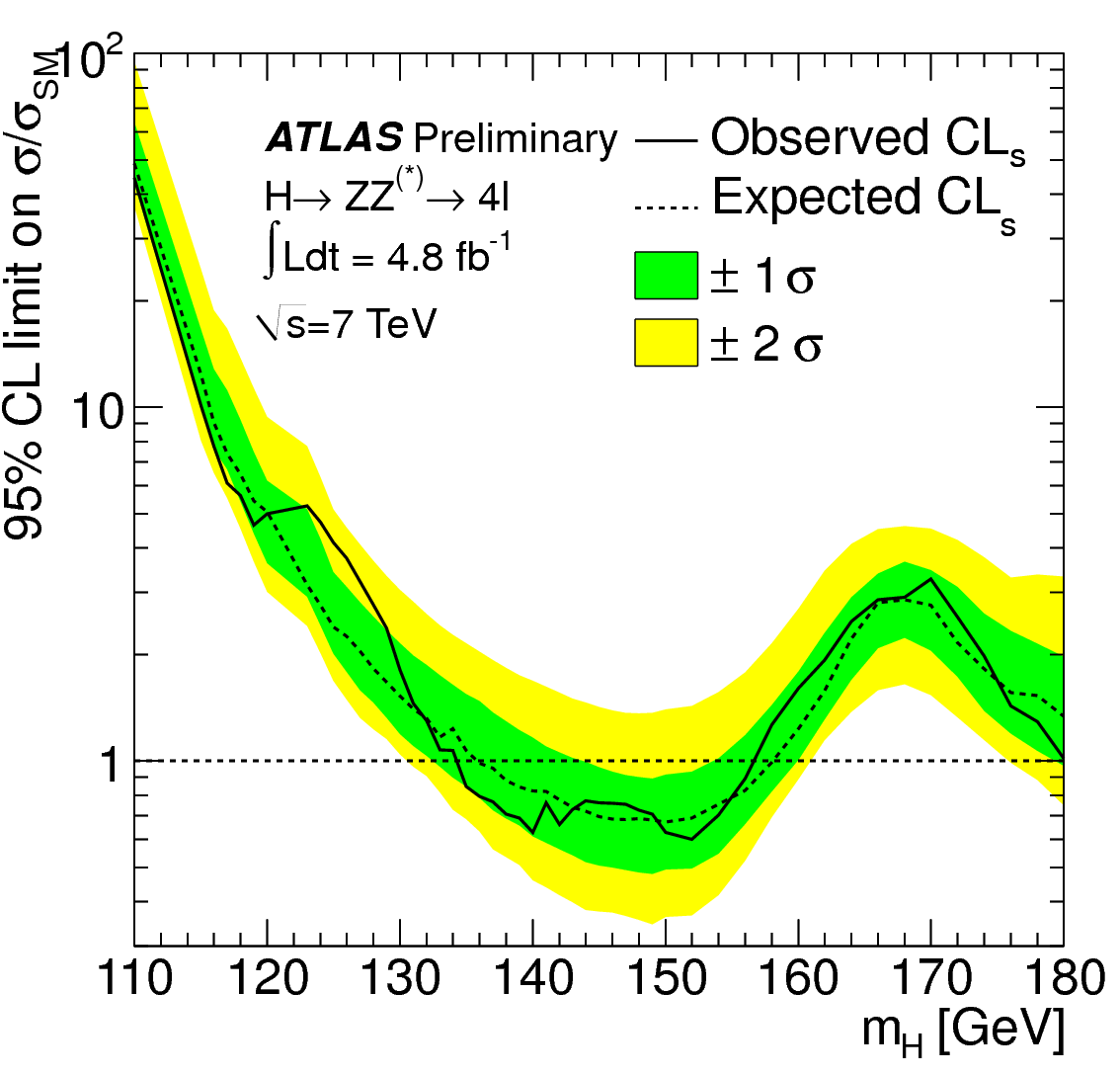 And on top of that, there is yet another decay mode, the Higgs particle decaying into a pair of W-bosons, but it is very difficult to see if anything exists at the extreme left of this plot:
And on top of that, there is yet another decay mode, the Higgs particle decaying into a pair of W-bosons, but it is very difficult to see if anything exists at the extreme left of this plot:
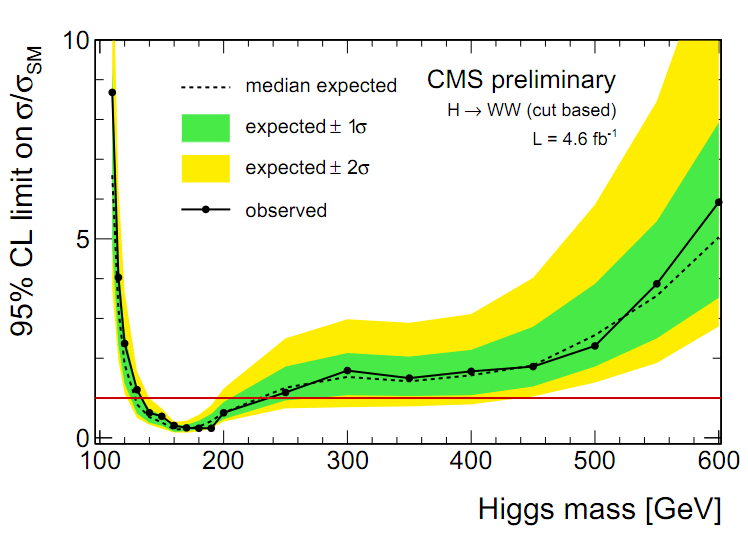 So why does this leave me skeptical? Simple. First, we know that the ZZ and WW decay modes are far more likely than the diphoton (γγ) decay.
So why does this leave me skeptical? Simple. First, we know that the ZZ and WW decay modes are far more likely than the diphoton (γγ) decay.
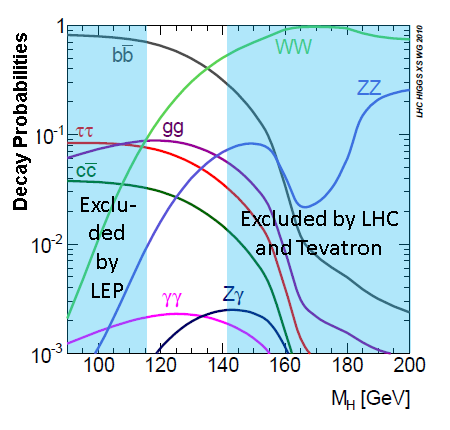 So naively, I would expect that if the signal is strong enough to produce noticeable bumps in the diphoton plot, very strong peaks should have been observed already in the ZZ and WW graphs. Instead, we see signals there that are even weaker than the bumps in the diphoton plots. While this is by no means rock solid proof that the Higgs does not exist, it makes me feel suspicious. Second… well, suppose that the Higgs does not exist. We always knew that it is the low energy region, namely the region that is still under consideration (the possibility of a Higgs that is heavier than 130 GeV is essentially excluded) where the Higgs search is the most difficult. So if no Higgs exist, this is precisely how we would expect the search to unfold: narrowing down the search window towards lower energies, just as the data becomes noisier and more and more bumps appear that could be misread as a Higgs that’s just not there.
So naively, I would expect that if the signal is strong enough to produce noticeable bumps in the diphoton plot, very strong peaks should have been observed already in the ZZ and WW graphs. Instead, we see signals there that are even weaker than the bumps in the diphoton plots. While this is by no means rock solid proof that the Higgs does not exist, it makes me feel suspicious. Second… well, suppose that the Higgs does not exist. We always knew that it is the low energy region, namely the region that is still under consideration (the possibility of a Higgs that is heavier than 130 GeV is essentially excluded) where the Higgs search is the most difficult. So if no Higgs exist, this is precisely how we would expect the search to unfold: narrowing down the search window towards lower energies, just as the data becomes noisier and more and more bumps appear that could be misread as a Higgs that’s just not there.
Then again, I could just be whistling in the dark. We won’t know until we know… and that “until” is at least another year’s worth of data that is to be collected at the LHC. Patience, I guess, is a virtue.
The BBC has a very informative article about the on-going search for the Higgs boson at CERN; and they even managed to squeeze in a sensible definition of the term, “inverse femtobarn”. I am impressed.
The latest OPERA results are in and they are very interesting. They used extremely tight bunches of protons this time, with a pulse width of only a few nanoseconds:
These bunches allowed the team to correlate individual neutrino events with the bunches that originated them. This is what they saw:
Numerically, the result is 62.1 ± 3.7 ns, consistent with their previously claimed result.
In my view, there are four possible categories of things that could have gone wrong with the OPERA experiment:
- Incorrectly synchronized clocks;
- Incorrectly measured distance;
- Unaccounted-for delays in the apparatus;
Statistical uncertainties.
Because this new result does not rely on the statistical averaging of a large number of events, item 4 is basically out. One down, three to go.
If at first you don’t succeed, try and try again… 18 times?
Fobos-Grunt is stuck in low Earth orbit and may be unsalvagable. The engines that were supposed to place it on a Mars-bound trajectory failed to start. In a few days, the probe may fall back to the Earth, raising concerns about tons of toxic hydrazine and nitrogen tetroxide fuel on board.
My fingers are firmly crossed. This is Russia’s first attempt to launch an interplanetary spacecraft since the 1996 failure of Mars 96, and a very ambitious attempt indeed, with a planned sample return from the Mars moon Phobos. Whatever it is that went wrong, I hope they can fix it in time.
Prior to Fobos-Grunt, Russia tried to launch a Mars probe 18 times. All were failures or partial failures, with only a few of them operating for a limited time after reaching Mars.
In his delightful collection of robot stories Cyberiad, Polish science-fiction author Stanislaw Lem tells us how to build a computer (a sentient computer, no less): the most important step is to pour a large number of transistors into a vat and stir.
This mental image popped into my mind as I was reading the last few pages of Andrew Pickering’s The Cybernetic Brain, subtitled Sketches of Another Future.
Beyond presenting a history of (chiefly British) cybernetics (and cyberneticians) the book’s main point is that cybernetics should be resurrected from the dead fringes as a nonmodern (the author’s word) alternative to the hegemony of modern science, and that the cybernetic approach of embracing unknowability is sometimes preferable to the notion that everything can be known and controlled. The author even names specific disasters (global warming, hurricane Katrina, the war in Iraq) as examples, consequences of the “high modernist” approach to the world.
Well, this is, I take it, the intended message of the book. But what I read from the book is a feely-goody New Age rant against rational (that is, fact and logic-based) thinking, characterized by phrases like “nonmodern” and “ontological theater”. The “high modernist” attitude that the author (rightfully) criticizes is more characteristic of 19th century science than the late 20th or early 21st centuries. And to be sure, the cyberneticians featuring in the book are just as guilty of arrogance as the worst of the “modernists”: after all, who but a true “mad scientist” would use an unproven philosophy as justification for electroshock therapy, or to build a futuristic control center for an entire national economy?
More importantly, the cyberneticians and Pickering never appear to go beyond the most superficial aspects of complexity. They conceptualize a control system for a cybernetic factory with a set of inputs, a set of outputs, and a nondescript blob in the middle that does the thinking; then, they go off and collect puddle water (!) that is supposed to be trained by, and eventually replace, the factory manager. The thinking goes something like this: the skills and experience of a manager form an “exceedingly complex” system. The set of biological and biochemical reactions in a puddle form another “exceedingly complex” system. So, we replace one with the other, do a bit of training, and presto! Problem solved.
These and similar ideas of course only reveal their proponents’ ignorance. Many systems appear exceedingly complex not because they are, but simply because their performance is governed by simple rules that the mathematician immediately recognizes as higher order differential equations, leading to chaotic behavior. The behavior of the cybernetic tortoise described in Pickering’s book appears complex only because it is unpredictable and chaotic. Its reaction in front of a mirror may superficially resemble the reaction of a cat, say, but that’s where the analogy ends.
In the end, the author laments that cybernetics has been marginalized by the hegemony of modernist science. I say no; I say cybernetics has been marginalized by its own failure to be useful. Much as cyberneticians would have preferred otherwise, you cannot build a sentient computer by pouring puddle water or a bag of transistors into a vat. The sentient machines of the future may be unknowable in the sense that their actions will be unpredictable, but it will be knowledge that builds them, not New Age ignorance.
 The world’s population is expected to reach the magic number of 7 billion today. Trick or treat!
The world’s population is expected to reach the magic number of 7 billion today. Trick or treat!
Federal government debt in the United States is expected to reach 100% of the country’s GDP today. Trick or treat!
Meanwhile, an almost unheard of October Nor’easter dumped over 30 inches of snow in some places in New England, leaving millions without power, thousands stranded in grounded airplanes or stuck trains, and a few people dead. Trick or treat!
Candy, anyone?
I’ve been skeptical about the validity of the OPERA faster-than-light neutrino result, but I’ve been equally skeptical about some of the naive attempts to explain it. Case in question: in recent days, a supposed explanation (updated here) has been widely reported in the popular press, and it had to do with a basic omission concerning the relativistic motion of GPS satellites. An omission that almost certainly did not take place… after all, experimentalists aren’t idiots. (That said, they may have missed a subtle statistical effect, such as a small difference in beam composition between the leading and trailing edges of a pulse. In any case, the neutrino spectrum should have been altered by Cherenkov-type radiation through neutral current weak interactions.)
Years ago, I expressed my (informed, I hope) skepticism concerning climate change in the form of several questions. One of these questions has been answered in a very resounding way by a most thorough independent analysis: yes, the warming trend is real and statistically significant.
So then, my questions are:
√ Is global warming real?
• Is it a future trend?
• Is it man-made (caused by CO2 emissions)?
• Is it bad for us?
The fundamental dilemma is that on the one hand, it seems irresponsible to advocate the spending of trillions of dollars (and potentially wrecking an already fragile global economy) before all these questions are answered. On the other hand, by the time we have all the answers, it may be too late to act.
But then, perhaps none of it matters. I do not believe that harebrained schemes like carbon trading are ever going to work. Humanity will continue to burn fossil fuels in ever increasing quantities in the foreseeable future, and atmospheric CO2 will inevitably increase. Ultimately, we may be faced with choices such as geoengineering or simple adaptation: moving from coastal lands to higher ground, evacuating areas that become unsurvivable in the summer, but also taking advantage of longer growing seasons or more fertile areas in the north.
Maybe I’ve been watching too much Doctor Who lately.
Many of my friends asked me about the faster-than-light neutrino announcement from CERN. I must say I am skeptical. One reason why I am skeptical is that no faster-than-light effect was observed in the case of supernova 1987A, which exploded in the Large Magellanic Cloud some 170,000 light years from here. Had there been such an effect of the magnitude supposedly observed at CERN, neutrinos from this supernova would have arrived years before visible light, but that was not the case. Yes, there are ways to explain away this (the neutrinos in question have rather different energy levels) but these explanations are not necessarily very convincing.
Another reason, however, is that faster-than-light neutrinos would be eminently usable in a technological sense; if it is possible to emit and observe them, it is almost trivial to build a machine that sends a signal in a closed timelike loop, effectively allowing us to send information from the future to the present. In other words, future me should be able to send present me a signal, preferably with the blueprints for the time machine of course (why do all that hard work if I can get the blueprints from future me for free?) So, I said, if faster-than-light neutrinos exist, then future me should contact present me in three…, two…, one…, now! Hmmm… no contact. No faster-than-light neutrinos, then.
But that’s when I suddenly remembered an uncanny occurrence that happened to me just hours earlier, yesterday morning. We ran out of bread, and we were also out of the little mandarin or clementine oranges that I like to have with my breakfast. So I took a walk, visiting our favorite Portuguese bakery on Nelson street, with a detour to the nearby Loblaws supermarket. On my way, I walked across a small parking lot, where I suddenly spotted something: a mandarin orange on the ground. I picked it up… it seemed fresh and completely undamaged. Precisely what I was going out for. Was it just a coincidence? Or perhaps future me was trying to send a subtle signal to present me about the feasibility of time machines?
If it’s the latter, maybe future me watched too much Doctor Who, too. Next time, just send those blueprints.
Now is the time to panic! At least this was the message I got from CNN yesterday, when it announced the breaking news: an explosion occurred at a French nuclear facility.
I decided to wait for the more sobering details. I didn’t have to wait long, thanks to Nature (the science journal, not mother Nature). They kindly informed me that “[…] the facility has been in operation since 1999. It melts down lightly-irradiated scrap metal […] It also incinerates low-level waste” and, most importantly, that “The review indicates that the specific activity of the waste over a ten-year period is 200×109 Becquerels. For comparison, that’s less than a millionth the radioactivity estimated to have been released by Fukushima […]”
Just to be clear, this is not the amount of radioactivity released by the French site in this accident. This is the total amount of radioactivity processed by this site in 12 years. No radioactivity was released by the accident yesterday.
These facts did not prevent the inevitable: according to Nature, “[t]he local paper Midi Libre is already reporting that several green groups are criticizing the response to the accident.” These must be the same green groups that just won’t be content until we all climbed back up the trees and stopped farting.
Since I mentioned facts, here are two more numbers:
- Number of people killed by the Fukushima quake: ~16,000 (with a further ~4,000 missing)
- Number of people killed by the Fukushima nuclear power station meltdowns: 0
All fear nuclear power! Panic now!


